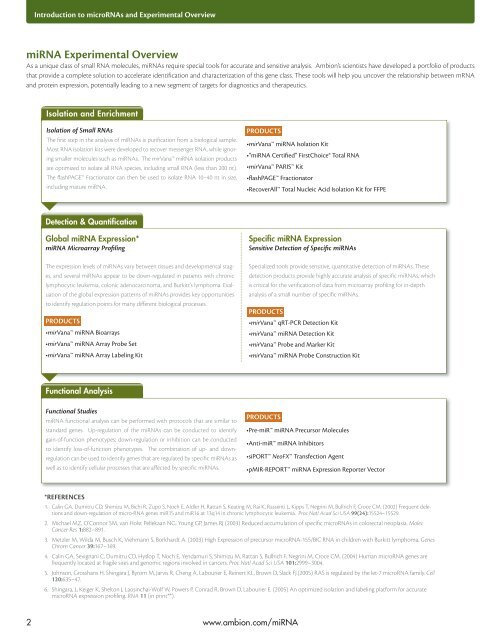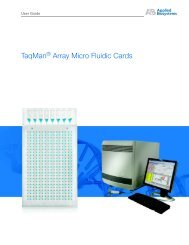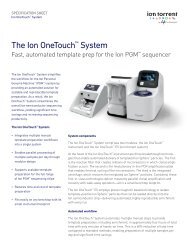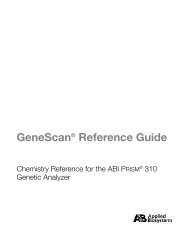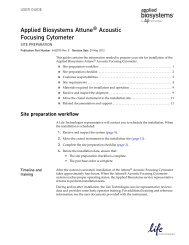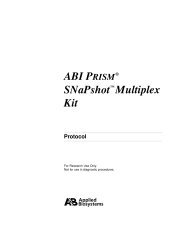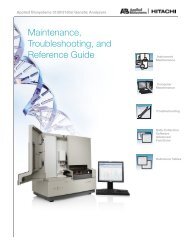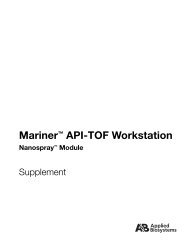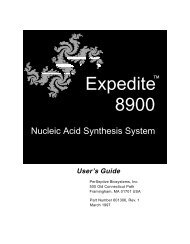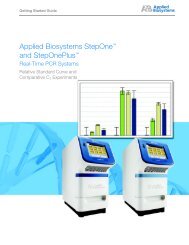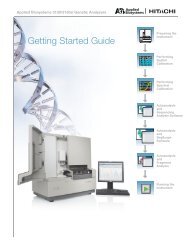miRNA Research Guide - Applied Biosystems
miRNA Research Guide - Applied Biosystems
miRNA Research Guide - Applied Biosystems
You also want an ePaper? Increase the reach of your titles
YUMPU automatically turns print PDFs into web optimized ePapers that Google loves.
2<br />
Introduction to microRNAs and Experimental Overview<br />
<strong>miRNA</strong> Experimental Overview<br />
As a unique class of small RNA molecules, <strong>miRNA</strong>s require special tools for accurate and sensitive analysis. Ambion’s scientists have developed a portfolio of products<br />
that provide a complete solution to accelerate identification and characterization of this gene class. These tools will help you uncover the relationship between mRNA<br />
and protein expression, potentially leading to a new segment of targets for diagnostics and therapeutics.<br />
Isolation and Enrichment<br />
Isolation of Small RNAs<br />
Th e fi rst step in the analysis of <strong>miRNA</strong>s is purifi cation from a biological sample.<br />
Most RNA isolation kits were developed to recover messenger RNA, while ignoring<br />
smaller molecules such as <strong>miRNA</strong>s. Th e mirVana <strong>miRNA</strong> isolation products<br />
are optimized to isolate all RNA species, including small RNA (less than 200 nt).<br />
Th e fl ashPAGE Fractionator can then be used to isolate RNA 10–40 nt in size,<br />
including mature <strong>miRNA</strong>.<br />
Detection & Quantifi cation<br />
Global <strong>miRNA</strong> Expression*<br />
<strong>miRNA</strong> Microarray Profi ling<br />
Th e expression levels of <strong>miRNA</strong>s vary between tissues and developmental stages,<br />
and several <strong>miRNA</strong>s appear to be down-regulated in patients with chronic<br />
lymphocytic leukemia, colonic adenocarcinoma, and Burkitt’s lymphoma. Evaluation<br />
of the global expression patterns of <strong>miRNA</strong>s provides key opportunities<br />
to identify regulation points for many diff erent biological processes.<br />
PRODUCTS<br />
•mirVana <strong>miRNA</strong> Bioarrays<br />
•mirVana <strong>miRNA</strong> Array Probe Set<br />
•mirVana <strong>miRNA</strong> Array Labeling Kit<br />
Functional Analysis<br />
Functional Studies<br />
<strong>miRNA</strong> functional analysis can be performed with protocols that are similar to<br />
standard genes. Up-regulation of the <strong>miRNA</strong>s can be conducted to identify<br />
gain-of-function phenotypes; down-regulation or inhibition can be conducted<br />
to identify loss-of-function phenotypes. Th e combination of up- and downregulation<br />
can be used to identify genes that are regulated by specifi c <strong>miRNA</strong>s as<br />
well as to identify cellular processes that are aff ected by specifi c <strong>miRNA</strong>s.<br />
*REFERENCES<br />
PRODUCTS<br />
•mirVana <strong>miRNA</strong> Isolation Kit<br />
•“<strong>miRNA</strong> Certifi ed” FirstChoice® Total RNA<br />
•mirVana PARIS Kit<br />
•fl ashPAGE Fractionator<br />
•RecoverAll Total Nucleic Acid Isolation Kit for FFPE<br />
Specifi c <strong>miRNA</strong> Expression<br />
Sensitive Detection of Specifi c <strong>miRNA</strong>s<br />
Specialized tools provide sensitive, quantitative detection of <strong>miRNA</strong>s. Th ese<br />
detection products provide highly accurate analysis of specifi c <strong>miRNA</strong>s, which<br />
is critical for the verifi cation of data from microarray profi ling for in-depth<br />
analysis of a small number of specifi c <strong>miRNA</strong>s.<br />
PRODUCTS<br />
•mirVana qRT-PCR Detection Kit<br />
•mirVana <strong>miRNA</strong> Detection Kit<br />
•mirVana Probe and Marker Kit<br />
•mirVana <strong>miRNA</strong> Probe Construction Kit<br />
PRODUCTS<br />
•Pre-miR <strong>miRNA</strong> Precursor Molecules<br />
•Anti-miR <strong>miRNA</strong> Inhibitors<br />
•siPORT NeoFX Transfection Agent<br />
•pMIR-REPORT <strong>miRNA</strong> Expression Reporter Vector<br />
1. Calin GA, Dumitru CD, Shimizu M, Bichi R, Zupo S, Noch E, Aldler H, Rattan S, Keating M, Rai K, Rassenti L, Kipps T, Negrini M, Bullrich F, Croce CM. (2002) Frequent deletions<br />
and down-regulation of micro-RNA genes miR15 and miR16 at 13q14 in chronic lymphocytic leukemia. Proc Natl Acad Sci USA 99(24):15524–15529.<br />
2. Michael MZ, O’Connor SM, van Holst Pellekaan NG, Young GP, James RJ (2003) Reduced accumulation of specifi c microRNAs in colorectal neoplasia. Molec<br />
Cancer Res 1:882–891.<br />
3. Metzler M, Wilda M, Busch K, Viehmann S, Borkhardt A. (2003) High Expression of precursor microRNA-155/BIC RNA in children with Burkitt lymphoma. Genes<br />
Chrom Cancer 39:167–169.<br />
4. Calin GA, Sevignani C, Dumitru CD, Hyslop T, Noch E, Yendamuri S, Shimizu M, Rattan S, Bullrich F, Negrini M, Croce CM. (2004) Human microRNA genes are<br />
frequently located at fragile sites and genomic regions involved in cancers. Proc Natl Acad Sci USA 101:2999–3004.<br />
5. Johnson, Grosshans H, Shingara J, Byrom M, Jarvis R, Cheng A, Labourier E, Reinert KL, Brown D, Slack FJ.(2005) RAS is regulated by the let-7 microRNA family. Cell<br />
120:635–47.<br />
6. Shingara, J., Keiger K, Shelton J, Laosinchai-Wolf W, Powers P, Conrad R, Brown D, Labourier E. (2005) An optimized isolation and labeling platform for accurate<br />
microRNA expression profi ling. RNA 11 (in print**).<br />
www.ambion.com/<strong>miRNA</strong>


